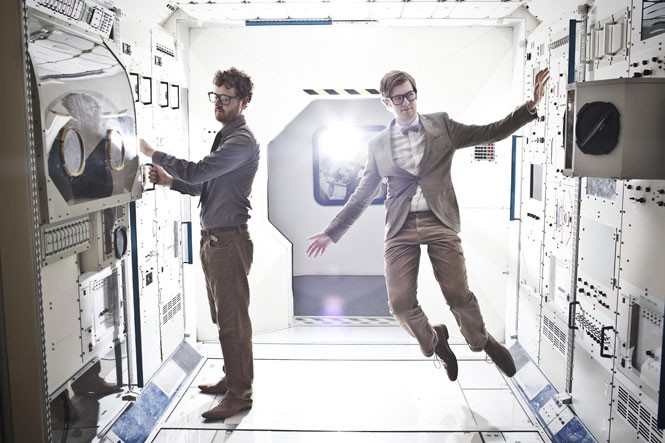
- Public Service Broadcasting
Public Service Broadcasting makes old things new again.
The pseudonymous British duo—multi-instrumentalist J. Willgoose Esq. and drummer Wrigglesworth—use archival film as a departure point for their songwriting, crafting new beats and music and grafting soundbites from old newsreels, in the place of lyrics, onto them.
Where 2013's Inform-Educate-Entertain flittedbetween a host of 20th-century events, the duo's latest album, The Race for Space—released in February—focuses solely on the first 15 years of the Space Age, mining the vaults of the American and Soviet space programs, unearthing samples that hadn't been heard, in some cases, in a half-century.
Willgoose wanted to bring back the single-subject approach of the band's earliest records—their first EP was about World War II propaganda—and space, he says, suggested itself as an obvious topic. He had always been interested in space and interstellar exploration, and the infinite scope of the cosmos lent itself well, he thought, to broadening PSB's sound, allowing him to work with different instrumentation and arrangement techniques.
The archive Willgoose uses on the new album ranges from the relatively obvious—Kennedy's 1962 moon speech on the quietly awe-inspiring title track—to obscure 1965 Soviet footage of Alexey Leonov's first spacewalk, which anchors the gripping "E.V.A." But Willgoose pairs the historical samples with music that's not just clever and enjoyable (see: the Daft Punk-y "Go!"), but also thematically fitting. Following the exuberant funk "Gagarin," which imparts the thrill of the first successful manned mission to space, is "Fire in the Cockpit." The song is all static, hiss and dolorous drone, implying the confusion and horror of the 1967 Apollo 1 disaster, which killed three American astronauts.
It's music that entertains as well as it informs; it tells a loose story, but smartly focuses on the inherent humanity and emotion—the excitement, bravery, joy and terror—of the era. After all, the idea behind Public Service Broadcasting, Willgoose asserts, is not to teach history, but to draw contemporary connections to long-ago events.
"I think re-framing stuff from the past, in the way that we hopefully have done, does sort of throw the present into relief," Willgoose says. "I think there are interesting parallels that can be drawn—and that's some of the point of what we're doing, really, is trying to re-examine this stuff that seems a long way away but actually still has meaning."
But that The Race for Space comes during a time when there's renewed interest in and public demand for space exploration? Well, that's just a coincidence.
"I'd like to say that we timed our release to match the comet landing," Willgoose says with a laugh. "But we're not that savvy. It was just really good luck."